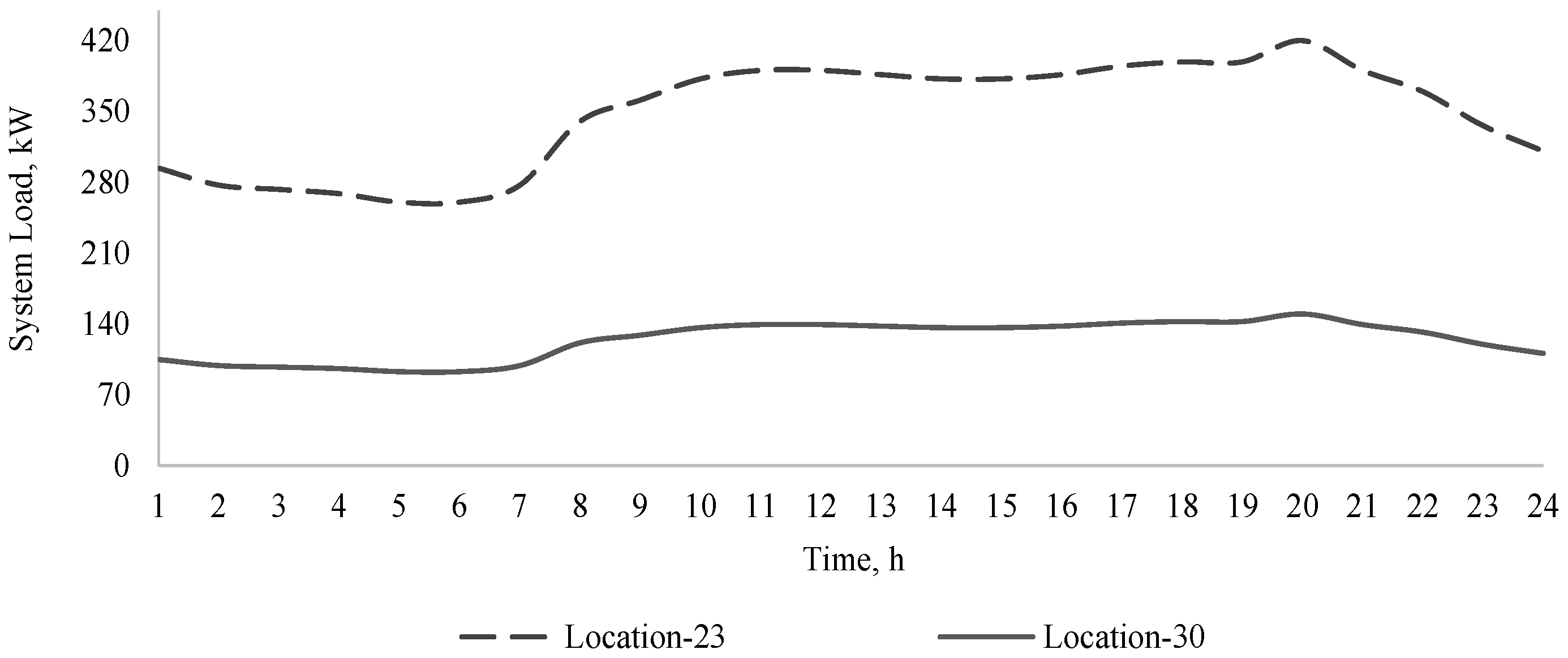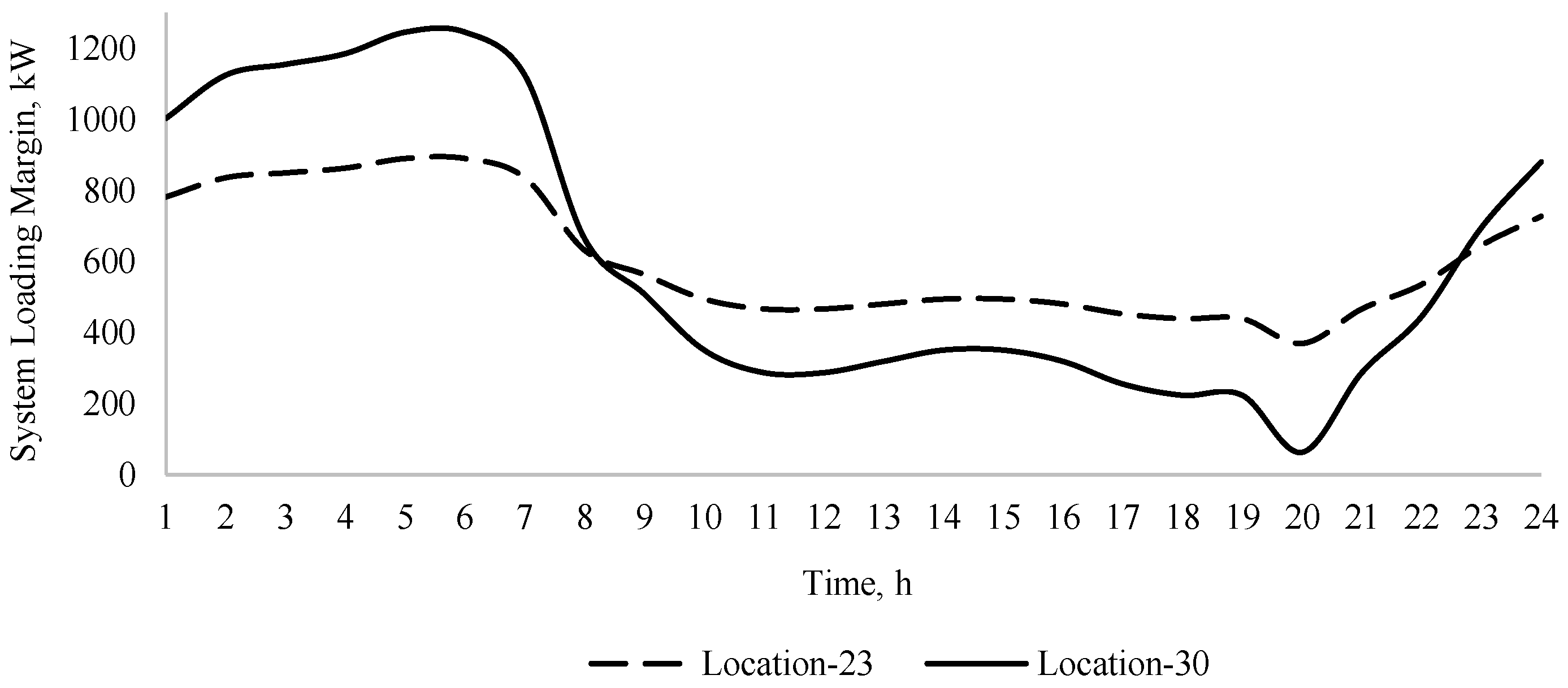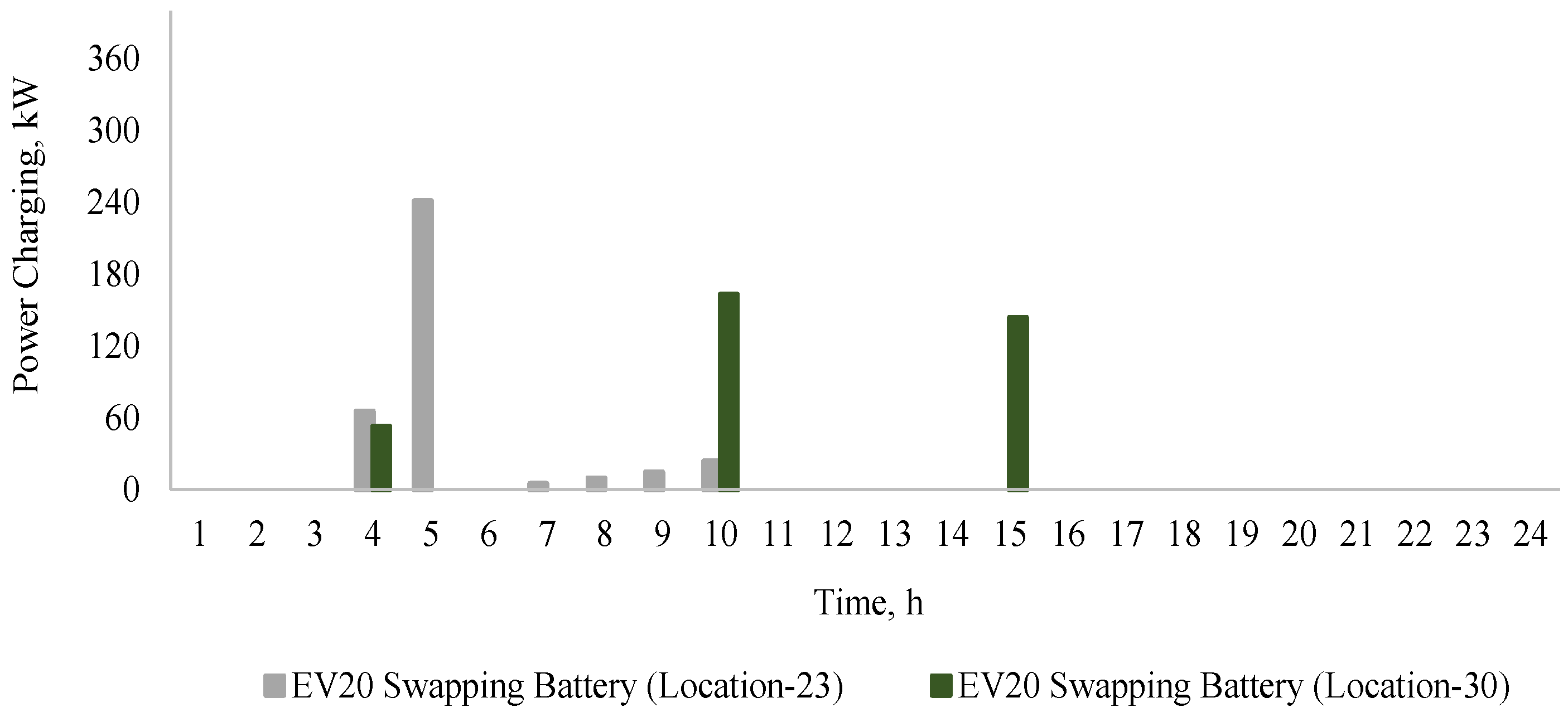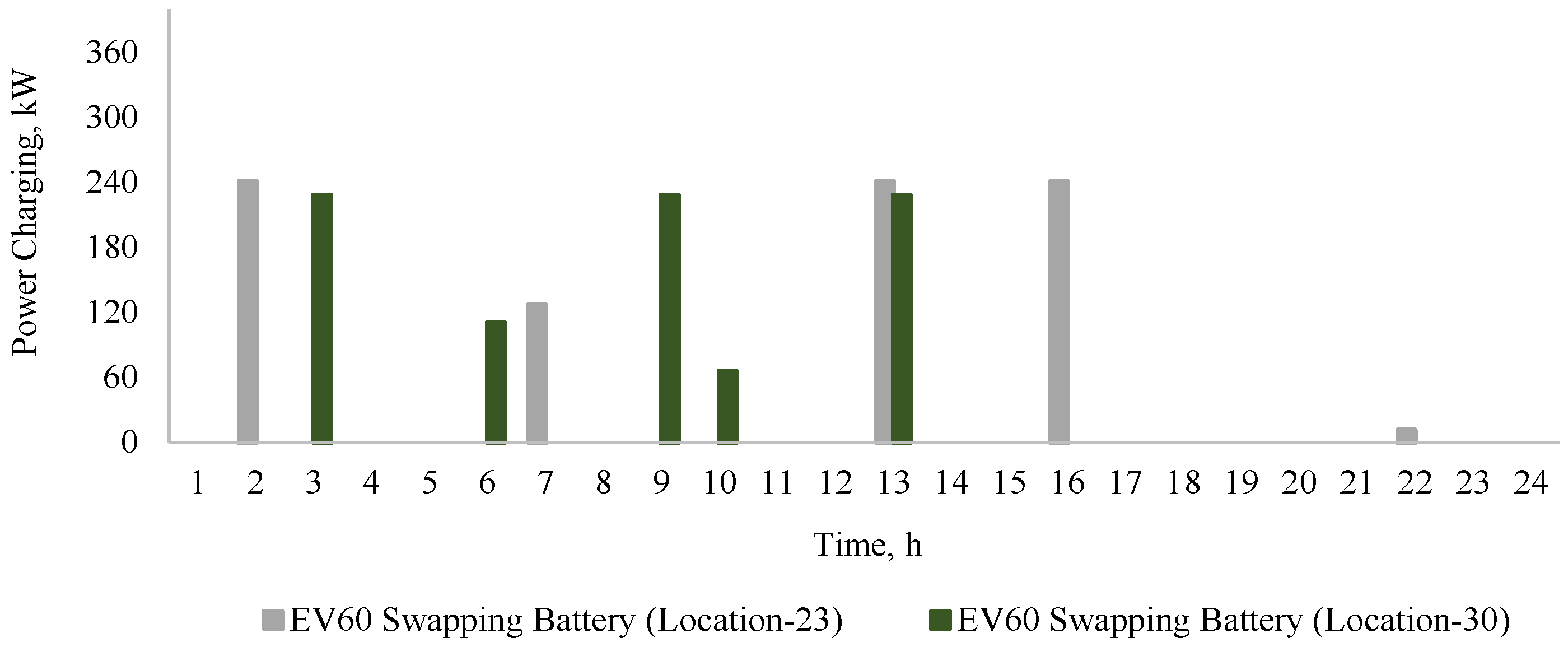Assessment of Distribution System Margins Considering Battery Swapping Stations
Abstract
1. Introduction
- Consideration of different EV charging infrastructures in the assessment of a distribution system capacity to accommodate EVs loads.
- Proposes a novel mathematical optimization model to maximize the distribution system margins, with taking into account the flexibility of the BSS loads and distribution grid limitations.
- Investigate whether the flexibility of BSS defers the need for system upgrades while accommodating EV loads in the distribution system.
2. Proposed Mathematical Optimization Model
3. Test System and Input Data
4. Results and Discussion
5. Conclusions
Funding
Data Availability Statement
Acknowledgments
Conflicts of Interest
Abbreviations
| Buses, N | |
| h | Time, h H |
| u | Location of distribution substation, u U |
| s | Location of charging stations, s S |
| a | Type of EV swapping batteries |
| Duration time, hour | |
| Hourly arrival rate of EVs | |
| Charging efficiency, % | |
| Active load of a distribution system, p.u. | |
| Reactive load of a distribution system, p.u. | |
| Number of EV swapping batteries in stock for each type | |
| EV swapped battery energy capacity | |
| Locational loading margin, p.u. | |
| Active and reactive power drawn, p.u. | |
| Power charging of EV swapping batteries, p.u. | |
| Feeder active and reactive power flow, p.u. | |
| State of charge of swapping batteries, p.u. | |
| V | Voltage magnitude, p.u. |
| Voltage phase angle, rad |
References
- Conti, J.; Holtberg, P.; Diefenderfer, J.; LaRose, A.; Turnure, J.T.; Westfall, L. International Energy Outlook 2016 with Projections to 2040. In Technical Report; USDOE Energy Information Administration (EIA): Washington, DC, USA, 2016. [Google Scholar]
- Du, J.; Ouyang, M. Review of electric vehicle technologies progress and development prospect in China. In Proceedings of the 2013 World Electric Vehicle Symposium and Exhibition (EVS27), Barcelona, Spain, 17–20 November 2013; pp. 1–8. [Google Scholar]
- Šepetanc, K.; Pandžić, H. A cluster-based operation model of aggregated battery swapping stations. IEEE Trans. Power Syst. 2019, 35, 249–260. [Google Scholar] [CrossRef]
- Bobanac, V.; Pandzic, H.; Capuder, T. Survey on electric vehicles and battery swapping stations: Expectations of existing and future EV owners. In Proceedings of the 2018 IEEE International Energy Conference (ENERGYCON), Limassol, Cyprus, 3–7 June 2018; pp. 1–6. [Google Scholar]
- Sindha, J. Impact of battery swapping stations on EV adoption and its contribution to peak load management. In Proceedings of the 2020 17th International Conference on the European Energy Market (EEM), Stockholm, Sweden, 16–18 September 2020; pp. 1–4. [Google Scholar]
- Liang, Y.; Zhang, X.; Xie, J.; Liu, W. An optimal operation model and ordered charging/discharging strategy for battery swapping stations. Sustainability 2017, 9, 700. [Google Scholar] [CrossRef]
- Moon, J.; Kim, Y.J.; Cheong, T.; Song, S.H. Locating battery swapping stations for a smart e-bus system. Sustainability 2020, 12, 1142. [Google Scholar] [CrossRef]
- Sarker, M.R.; Pandžić, H.; Ortega-Vazquez, M.A. Optimal operation and services scheduling for an electric vehicle battery swapping station. IEEE Trans. Power Syst. 2014, 30, 901–910. [Google Scholar] [CrossRef]
- Zheng, Y.; Dong, Z.Y.; Xu, Y.; Meng, K.; Zhao, J.H.; Qiu, J. Electric vehicle battery charging/swap stations in distribution systems: Comparison study and optimal planning. IEEE Trans. Power Syst. 2013, 29, 221–229. [Google Scholar] [CrossRef]
- Revankar, S.R.; Kalkhambkar, V.N. Grid integration of battery swapping station: A review. J. Energy Storage 2021, 41, 102937. [Google Scholar] [CrossRef]
- Amiri, S.S.; Jadid, S.; Saboori, H. Multi-objective optimum charging management of electric vehicles through battery swapping stations. Energy 2018, 165, 549–562. [Google Scholar] [CrossRef]
- Sui, Q.; Li, F.; Wu, C.; Feng, Z.; Lin, X.; Wei, F.; Li, Z. Optimal scheduling of battery charging–swapping systems for distribution network resilience enhancement. Energy Rep. 2022, 8, 6161–6170. [Google Scholar] [CrossRef]
- Zeng, B.; Luo, Y.; Liu, Y. Quantifying the contribution of EV battery swapping stations to the economic and reliability performance of future distribution system. Int. J. Electr. Power Energy Syst. 2022, 136, 107675. [Google Scholar] [CrossRef]
- Alharbi, W.; Bhattacharya, K. Electric Vehicle Charging Facility as a Smart Energy Microhub. IEEE Trans. Sustain. Energy 2017, 8, 616–628. [Google Scholar] [CrossRef]
- Alharbi, W.; Bhattacharya, K. Flexibility provisions from a fast charging facility equipped with DERs for wind integrated grids. IEEE Trans. Sustain. Energy 2018, 10, 1006–1014. [Google Scholar] [CrossRef]
- Zhang, T.; Chen, X.; Yu, Z.; Zhu, X.; Shi, D. A Monte Carlo simulation approach to evaluate service capacities of EV charging and battery swapping stations. IEEE Trans. Ind. Inform. 2018, 14, 3914–3923. [Google Scholar] [CrossRef]
- Chaudhari, K.; Kandasamy, N.K.; Krishnan, A.; Ukil, A.; Gooi, H.B. Agent-based aggregated behavior modeling for electric vehicle charging load. IEEE Trans. Ind. Inform. 2018, 15, 856–868. [Google Scholar] [CrossRef]
- Ahmad, F.; Alam, M.S.; Shariff, S.M. A cost-efficient energy management system for battery swapping station. IEEE Syst. J. 2019, 13, 4355–4364. [Google Scholar] [CrossRef]
- Aghajan-Eshkevari, S.; Azad, S.; Nazari-Heris, M.; Ameli, M.T.; Asadi, S. Charging and discharging of electric vehicles in power systems: An updated and detailed review of methods, control structures, objectives, and optimization methodologies. Sustainability 2022, 14, 2137. [Google Scholar] [CrossRef]
- Li, Y.; Han, M.; Yang, Z.; Li, G. Coordinating flexible demand response and renewable uncertainties for scheduling of community integrated energy systems with an electric vehicle charging station: A bi-level approach. IEEE Trans. Sustain. Energy 2021, 12, 2321–2331. [Google Scholar] [CrossRef]
- He, C.; Zhu, J.; Lan, J.; Li, S.; Wu, W.; Zhu, H. Optimal planning of electric vehicle battery centralized charging station based on EV load forecasting. IEEE Trans. Ind. Appl. 2022, 58, 6557–6575. [Google Scholar] [CrossRef]
- Reddy, K.R.; Meikandasivam, S. Load flattening and voltage regulation using plug-in electric vehicle’s storage capacity with vehicle prioritization using anfis. IEEE Trans. Sustain. Energy 2018, 11, 260–270. [Google Scholar] [CrossRef]
- Zeng, B.; Dong, H.; Sioshansi, R.; Xu, F.; Zeng, M. Bilevel robust optimization of electric vehicle charging stations with distributed energy resources. IEEE Trans. Ind. Appl. 2020, 56, 5836–5847. [Google Scholar] [CrossRef]
- Wu, H.; Pang, G.K.H.; Choy, K.L.; Lam, H.Y. An optimization model for electric vehicle battery charging at a battery swapping station. IEEE Trans. Veh. Technol. 2017, 67, 881–895. [Google Scholar] [CrossRef]
- Zhong, X.; Zhong, W.; Liu, Y.; Yang, C.; Xie, S. Cooperative operation of battery swapping stations and charging stations with electricity and carbon trading. Energy 2022, 254, 124208. [Google Scholar] [CrossRef]
- Shaker, M.H.; Farzin, H.; Mashhour, E. Joint planning of electric vehicle battery swapping stations and distribution grid with centralized charging. J. Energy Storage 2023, 58, 106455. [Google Scholar] [CrossRef]
- Koirala, K.; Tamang, M.; Shabbiruddin. Planning and establishment of battery swapping station—A support for faster electric vehicle adoption. J. Energy Storage 2022, 51, 104351. [Google Scholar] [CrossRef]
- Gataullin, T.M.; Gataullin, S.T. Best economic approaches under conditions of uncertainty. In Proceedings of the 2018 Eleventh International Conference “Management of Large-Scale System Development” (MLSD), Moscow, Russia, 1–3 October 2018; pp. 1–3. [Google Scholar]
- Wu, Y.; Zhuge, S.; Han, G.; Xie, W. Economics of Battery Swapping for Electric Vehicles Simulation-Based Analysis. Energies 2022, 15, 1714. [Google Scholar] [CrossRef]
- Li, J.; Wang, F.; He, Y. Electric vehicle routing problem with battery swapping considering energy consumption and carbon emissions. Sustainability 2020, 12, 10537. [Google Scholar] [CrossRef]
- Liang, Y.; Ding, Z.; Zhao, T.; Lee, W.J. Real-time operation management for battery swapping-charging system via multi-agent deep reinforcement learning. IEEE Trans. Smart Grid 2022, 14, 559–571. [Google Scholar] [CrossRef]
- Islam, M.S.; Mithulananthan, N.; Hung, D.Q. A day-ahead forecasting model for probabilistic EV charging loads at business premises. IEEE Trans. Sustain. Energy 2017, 9, 741–753. [Google Scholar] [CrossRef]
- Li, B.; Xie, K.; Zhong, W.; Huang, X.; Wu, Y.; Xie, S. Operation Management of Electric Vehicle Battery Swapping and Charging Systems: A Bilevel Optimization Approach. IEEE Trans. Intell. Transp. Syst. 2022, 24, 528–540. [Google Scholar] [CrossRef]
- Florea, B.C.; Taralunga, D.D. Blockchain IoT for smart electric vehicles battery management. Sustainability 2020, 12, 3984. [Google Scholar] [CrossRef]
- Infante, W.; Ma, J. Coordinated management and ratio assessment of electric vehicle charging facilities. IEEE Trans. Ind. Appl. 2020, 56, 5955–5962. [Google Scholar] [CrossRef]
- Zelenina, A.; Petrosov, D.; Pleshakova, E.; Osipov, A.; Ivanov, M.; Choporov, O.; Preobrazhenskiy, Y.; Petrsova, N.; Roga, S.; Lopatnuk, L.; et al. Modeling of management processes in distributed organizational systems. Procedia Comput. Sci. 2022, 213, 377–384. [Google Scholar] [CrossRef]
- Jia, W.; Ding, T.; Bai, J.; Bai, L.; Yang, Y.; Blaabjerg, F. Hybrid Swapped Battery Charging and Logistics Dispatch Model in Continuous Time Domain. IEEE Trans. Veh. Technol. 2022, 71, 2448–2458. [Google Scholar] [CrossRef]
- Sun, B.; Tan, X.; Tsang, D.H. Optimal charging operation of battery swapping and charging stations with QoS guarantee. IEEE Trans. Smart Grid 2017, 9, 4689–4701. [Google Scholar] [CrossRef]
- Alharbi, W.; Humayd, A.S.B.; Praveen, R.P.; Awan, A.B.; Anees, V.P. Optimal Scheduling of Battery-Swapping Station Loads for Capacity Enhancement of a Distribution System. Energies 2022, 16, 186. [Google Scholar] [CrossRef]
- Baran, M.E.; Wu, F.F. Network reconfiguration in distribution systems for loss reduction and load balancing. IEEE Power Eng. Rev. 1989, 9, 101–102. [Google Scholar] [CrossRef]
- Pinheiro, J.; Dornellas, C.; Schilling, M.T.; Melo, A.; Mello, J. Probing the new IEEE reliability test system (RTS-96): HL-II assessment. IEEE Trans. Power Syst. 1998, 13, 171–176. [Google Scholar] [CrossRef]
- Alharbi, W.; Bhattacharya, K. Incentive Design for Flexibility Provisions From Residential Energy Hubs in Smart Grid. IEEE Trans. Smart Grid 2021, 12, 2113–2124. [Google Scholar] [CrossRef]
- U.S. Department of Transportation. National Household Travel Survey. Available online: http://nhts.ornl.gov (accessed on 8 March 2023).
- Alharbi, W.; Almutairi, A. Planning Flexibility with Non-Deferrable Loads Considering Distribution Grid Limitations. IEEE Access 2021, 9, 25140–25147. [Google Scholar] [CrossRef]











Disclaimer/Publisher’s Note: The statements, opinions and data contained in all publications are solely those of the individual author(s) and contributor(s) and not of MDPI and/or the editor(s). MDPI and/or the editor(s) disclaim responsibility for any injury to people or property resulting from any ideas, methods, instructions or products referred to in the content. |
© 2023 by the author. Licensee MDPI, Basel, Switzerland. This article is an open access article distributed under the terms and conditions of the Creative Commons Attribution (CC BY) license (https://creativecommons.org/licenses/by/4.0/).
Share and Cite
Alharbi, W. Assessment of Distribution System Margins Considering Battery Swapping Stations. Sustainability 2023, 15, 6782. https://doi.org/10.3390/su15086782
Alharbi W. Assessment of Distribution System Margins Considering Battery Swapping Stations. Sustainability. 2023; 15(8):6782. https://doi.org/10.3390/su15086782
Chicago/Turabian StyleAlharbi, Walied. 2023. "Assessment of Distribution System Margins Considering Battery Swapping Stations" Sustainability 15, no. 8: 6782. https://doi.org/10.3390/su15086782
APA StyleAlharbi, W. (2023). Assessment of Distribution System Margins Considering Battery Swapping Stations. Sustainability, 15(8), 6782. https://doi.org/10.3390/su15086782




